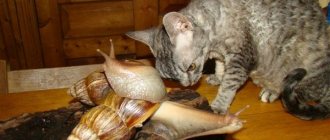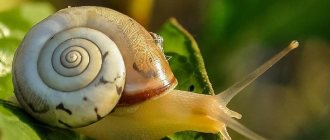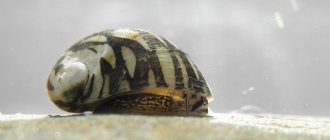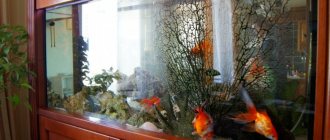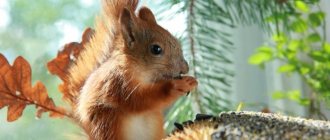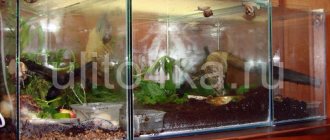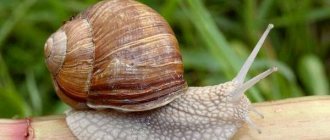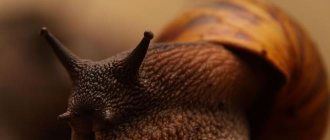Recently, land snails can be found more and more often as pets. And this is not surprising, because mollusks are unpretentious in care and maintenance. They do not require special attention. Besides that, they are quite cute and attractive. Today, Arkhatina are gradually gaining popularity, second only to Achatina. In order for your pet to grow up healthy, you need to consider some important points. Namely, to understand what conditions should be created in the terrarium, how to properly care for it, and what to feed.
general description
Archaeological snails are native to Africa. Often representatives of this species are called African beauties. Considering the character, it is worth noting that individuals are quite capricious. Thus, if the mollusks feel dissatisfied, they begin to chew on themselves. It is extremely difficult to rid them of such a habit.
Arhahatina snails come from Africa
Calm behavior. Most of the time they are lazy. Completely indifferent to swimming under warm running water. However, I enjoy bathing in the tubs. They are characterized by excessive timidity and caution. In case of danger, they immediately bury themselves in the ground.
Characterized by excessive timidity and caution
During the maintenance process, it is necessary to give special supplements, which include large amounts of calcium. They are unpretentious in food, but cucumbers are most often refused. The main delicacies are tomatoes, pumpkin, zucchini.
Appearance
If we consider archaea, we should first of all pay attention to the shell. The shell is round in shape, the apex is not sharp. Many experienced snail breeders are able to determine whether they belong to a specific species by the shade of the apex.
The shell is round in shape, the apex is not sharp
All representatives of this species, including Victoria snails, have the tip of their leg in the shape of the letter V. There is also a characteristic groove. You can feel it if you wish. To do this, wet your finger a little and gently run it along the snail’s tail.
In addition, archaeologists have quite hard and rough skin. If you run your finger over the body of a mollusk, you can feel that the skin is divided into small cells. The body is rough to the touch.
Natural habitat
Land snails of this species can be seen not only in home terrariums. They also live in natural conditions. Thus, they can be found in Africa, to be more precise, in Zaire and Cameroon. The average life expectancy is 5 years.
Behavior
Before purchasing a giant land snail, you should take into account its behavioral characteristics. If arhatines are chosen as a pet, then it is important to understand that this species is quite slow. Mollusks are leisurely, they move little. You could even call them lazy. In addition, representatives of these African gastropods are characterized by excessive timidity. They don't like to explore new things. It is quite difficult to get used to the changes that have appeared in the terrarium. The best option is not to touch or move anything extra. And after general cleaning, return them to their original places.
Reproduction
Undoubtedly, selection and acquisition, maintenance and care are important points that are worth studying. Equally important is reproduction. As practice shows, archaeologists often reproduce at home without much effort. Each individual has male and female reproductive organs. Thanks to this, spontaneous fertilization is possible.
Each individual has male and female reproductive organs
Sexual maturity occurs at the age of 12-18 months. As a rule, there are up to 20 eggs in a clutch, each about 2 cm in size. If breeding is not planned, then the eggs of archahatine snails can be easily destroyed. Otherwise, you will have to make sure that the conditions in the aquarium meet the requirements.
Mollusks are leisurely, they move little
The terrarium must be clean. The temperature and humidity levels are constant. As soon as the snails are born, they are immediately transferred to a cabbage leaf. If you leave the offspring in the ground, they will easily suffocate and die.
The issue of reproduction
Achatina eggs are laid 3 cm deep into the substrate
Most Achatina begin to reproduce at the age of 9-18 months. The incubation period can last from 4 to 8 weeks, depending on the specific type of mollusk. However, keep in mind that if the substrate thickness is less than 3 cm, Achatina reproduce poorly, since they have nowhere to place a clutch of eggs.
Giant snails are hermaphrodites, like all land gastropods. Therefore, if you do not want to get offspring, get one snail or place your pets in different terrariums. If unwanted masonry does appear, it must be removed from the aquarium and placed in the freezer or boiled.
The resulting snails should not be released into the wild. They can cause serious harm to gardeners, as they readily reproduce and consume everything in their path.
In England there is even a special law prohibiting the release of African mollusks into the street.
Types of archaeologists
There are a large number of varieties of archahatine snails. They differ from each other not only in size, but also in color schemes and behavioral characteristics.
Arhahatina Marginata
Marghinata Eduardi. In adult individuals, the size of the shell varies from 8 to 10 cm. There are stripes on the shell, the color is brown. The apex is yellow or beige.
Marghinata Eduardi
Marginata Egregia. Snails grow up to 10 cm maximum. The carapace is quite bright, mostly dark shades. Apex pink.
Marginata Egregia
Follow the links to read a detailed description of Arhahatina Marginata Marginata. The difference is the massive round-shaped shell. They grow up to 18 cm. The main shade of the shell is light brown or dark brown. The stripes are evenly distributed throughout the shell.
Marginata Marginata
Marginata Ovum. The shell is quite large, about 18-20 cm. A distinctive feature is the yellow apex. The main shade is yellow, beige. The stripes are brown.
Marginata Ovum
Arhahatina Benin
Arhahatina Benin is the most popular. It has a white apex. The carapace is coffee-colored, rather pale lines and light pink veins can be substituted. Adults grow up to 8 cm in length.
Story
Achatina were brought to Europe from southern exotic countries. They live in large numbers in Africa, South America, Mauritius and other southern islands. Due to their enormous fertility, they are able to quickly populate entire colonies over vast territories, eating vegetation and damaging agricultural land. Therefore, in some tropical countries it is prohibited to breed and sell them. But in the temperate climate zone they do not survive and are able to reproduce only in artificial conditions.
They are considered the largest among all types of snails. The size of an adult individual can reach 20 cm. This snail attracts with its gentle disposition, lack of noise, odor and allergies, as well as a variety of shell colors.
Contents of archaic houses
Quite often, snails are chosen as pets. It is not difficult to care for and maintain them. This usually takes little time. In addition, they are easy to breed without any effort. All that is required is to properly prepare their future home and maintain suitable conditions. If all these conditions are met, the snails will feel comfortable and delight their owners with an attractive appearance, good health and offspring.
House
If you plan to have a mollusk as a pet, you will need to purchase a house - a terrarium - to keep it. If necessary, it can be replaced with a regular aquarium or a transparent plastic container. The most important condition is that the future home must be spacious. Each individual should have at least 15 liters.
Snails are quite often chosen as pets.
The selected container must be constantly ventilated. It is not recommended to place the house in close proximity to heating appliances. And also in places where there are drafts. There should also be constant ventilation. For these purposes, holes are made in the container. They should be made with a small diameter. Otherwise, the pets will be able to get out of their house and crawl.
Priming
Soil is the second most important element. Without it, keeping snails is impossible. The substrate is required primarily to ensure that the optimal level of humidity is maintained in the terrarium. In addition, it is very important for the mollusks themselves. This is due to the fact that they prefer to bury themselves in the ground while resting.
Soil is the second most important element
Taking care of the soil is also necessary. It should be irrigated daily with water at room temperature. Wash once a week. You can add new substrate little by little as needed. Every month the soil is completely changed. The terrarium is thoroughly cleaned. Fine coconut substrate and sand are ideal as a substrate for snails.
Lighting
Almost all varieties of arhahatina love bright lighting. However, it is not necessary to install a special lighting device above the terrarium. To make pets feel comfortable, natural lighting will be enough. There should be no light at night. During this period, gastropods are most active.
Temperature
For Achatina and Arkhatina, the parameters in the terrarium should be constant. Thus, it is worth monitoring the temperature, which should not fluctuate. As practice shows, arhahatines react painfully to temperatures that are too high and too low. The optimal value is considered to be between +23 and +28 degrees. To ensure that the indicator does not change, it is worth choosing the correct location of the pet house. Thus, the terrarium should not be located near heating devices or near windows in direct sunlight.
Humidity
Home care for snails should be of high quality. The level of humidity, as well as temperature, is of great importance. The optimal humidity level is considered to be within 80%. In addition, you should constantly ensure that this parameter always remains unchanged. There should be no hesitation. Otherwise, it will negatively affect your pets. The substrate should not be too dry or too wet. To do this, ventilation is installed in the terrarium.
How do Achatina snails reproduce?
During the first year of life, the snail actively grows and gains strength. For the appearance of viable offspring, several conditions must be met:
- air temperature 25-28 degrees;
- humidity 60-80%;
- mineral supplements, fertilizers, vitamins;
- spacious container;
- clean soil.
At what age do snails reproduce? The sexual maturity of the mollusk is signaled by a protruding growth on the right side of the neck. Mating of Achatina occurs over a period of 2 hours; during love play, the mollusks actively rub and touch their heads. Fertilization occurs through the genital organs located on the neck. During and after mating, snails should not be disturbed.
Food arhahatina
Mollusks love not only comfortable living conditions, but also delicious food. This species of gastropod has a good appetite. The advantage is that individuals are unpretentious and eat whatever they give. Thus, they are able to eat almost anything that is offered by the owner.
However, this does not mean that you can include everything in your diet. Fresh vegetables are ideal as food. For example, cucumbers, cabbage and lettuce leaves, carrots, zucchini, tomatoes. If you offer potatoes, they will refuse it.
Shellfish love not only comfortable living conditions, but also delicious food.
In addition, they will not refuse fruits. Fresh apples are the favorite. However, they will not refuse to enjoy fresh melon, watermelon, eggs and even mushrooms.
It is not recommended to introduce salty, sweet, or spicy foods into your diet. Since this can lead to a decrease in appetite. If not fed properly, the snails will die.
To ensure that the mollusks are always in good condition, special additives are periodically given. They contain calcium and protein. They are necessary for growth and development. You can saturate your body with a sufficient amount of protein using meat products and bone meal. Chalk and eggshells are often added to food.
Advice! Small snails are fed with grated vegetables and fruits.
Habitat
This genus began its existence on the coast of East Africa, where the climate is characterized by high temperature and humidity. Now wild snails have moved to Central Africa, as well as to southern Asia. In Japan and Brazil you can still find farms where Achatina is mined. In Europe and America, giant snails are found as pets.
The type of terrain and relief does not matter for the mollusk. Giant snails can be found everywhere where there is a relatively warm climate and high humidity.
At temperatures above +10 °C, the snail becomes active and becomes an agricultural pest. If it is too cold, the animal hibernates.
Photo gallery of the Achatina snail:
Diseases
The archahatina snail is a living creature. Therefore, illnesses are also common to her. Gastropods often suffer from the appearance of parasites. As a rule, individuals imported from the tropics are susceptible to diseases. It is recommended to purchase shellfish that have been bred and grown at home. These parasites are not transmitted to humans. However, you should wash your hands thoroughly with soap.
Gastropods often suffer from the appearance of parasites
Another common problem that snail breeders have to deal with is damage to the shell. This happens if the pet falls from the wall of the terrarium. There's no need to panic. The snail will remain alive. But provided that the shell is restored in a timely manner.
The organism of an archaeologist whose shell is damaged can be attacked by infection. It's easy to prevent this. Antiseptic preparations are sufficient for the chipped area. At first the body will be visible. Gradually everything will heal.
Achatina and Archachatina snails should not experience stress
In addition, individuals often rub against each other. Which leads to damage to the shell. In this case, it is recommended to lubricate the sink with special preparations that will repel other mollusks. Before choosing a drug, you should consult a specialist.
Achatina and archachatina snails should not experience stress. It is not recommended to pick them up often. During the day, gastropods like to rest and sleep. Contact with them should be minimized. The best time to communicate with pets is in the evening.
Remove the snail from the surface carefully. There is a high probability of damaging the sink. The pet's leg is moistened with a small amount of water, a finger is placed under it, and the other hand is lifted by the shell.
Behavior of Achatina albopicta
Achatina albopicta is a quiet snail; it is active only at night. Moderately active and curious. Albopicta is unpretentious in care and nutrition. She can be trained to eat according to the time and place where her feeder with food is located. The snail easily makes contact with a person and after a few days recognizes the owner by smell, and hides from the stranger in the shell.
If there is a lot of crowding in the terrarium, it can show aggression towards other species of Achatina snails.
Achatina albopicta is used for cosmetic purposes. Snail mucus promotes rapid healing of wounds and burns, smoothes rough scars and deep wrinkles. And there are legends about the dietary qualities of snail meat and caviar. Dishes of meat and snail caviar. Many snail lovers keep Achatina albopicta as an ideal pet, as they are hypoallergenic. And you?
